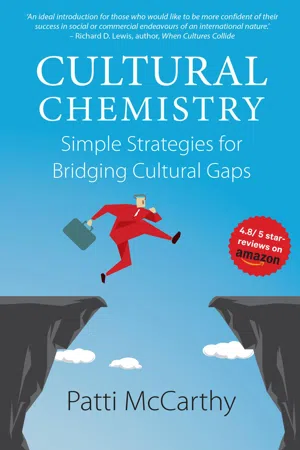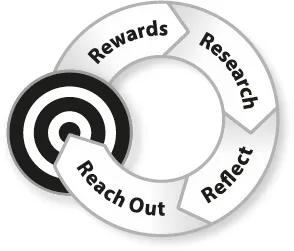![]()
Introducing the Four R’s
Becoming more aware of and more comfortable with cultural differences is not an ‘opt in’ any more. For any individual or any business who hopes to work seamlessly with clients from many different countries, it is an essential requirement. So, where to start?
Consider while you are reading how easily so many of the difficult situations described could have been avoided with a little forward planning, tolerance and patience. All of these qualities and more are needed if we are to truly embrace and enjoy cultural differences and I have bound them together in a simple, but effective four-step approach which I call the Four R’s.
The four steps consist of Rewards, Research, Reflect and Reach Out.
Note that none of the Four R’s refers to either ‘Respect’ or ‘Rocket-science’. Many people would argue that respect is the cornerstone of any successful cross-cultural interaction, but I believe that if you haven’t done your research and therefore lack knowledge, you don’t understand why someone does something. Without this back story, it is much more likely that you will find that behaviour ‘difficult’ and you will therefore be less likely to be able to respect it.
Take, for example, the habit of saying yes but meaning no, which many Westerners find one of the most baffling traits they encounter when working with people from Asian countries and which is discussed further in Chapter 4. If we understand that for people from Asian countries, maintaining harmony is one of the most important cultural drivers, we can start to appreciate why this happens. If we add to that knowledge the fact that most Asian societies are very high context and that meaning is conveyed in far more than just words, we start to understand that we need to ‘listen’ for far more than words. If our Japanese host or business colleague smiles gently at us, looks away, asks us to remember another occasion on which we met and says regretfully that what we are asking for “might take some time”, it must be understood that is the equivalent of an Englishman’s emphatic “over my dead body!” – but stated with the delicacy that the Japanese prefer.
Let’s go through the Four R’s step by step.
Step 1: Rewards
What’s in it for you?
We are all motivated by rewards, whether tangible or intangible. Why do you want to learn about cultural differences? What benefit will you get? What’s in it for you?
• Maybe you feel that your product could be hugely successful in an overseas market, but you need a local partner to work with you.
• Perhaps there is a colleague or member of your team whom you feel has great potential, but whom you sense is not fully engaged.
• Perhaps there is a client or a supplier whom you find very abrasive and annoying and you’d like to improve that relationship.
• Maybe there is the chance of an expatriate assignment in the future and you would like to demonstrate your suitability for the role.
• Or maybe you are simply going on holiday somewhere new and you want to learn a bit about their customs and language.
There are multiple reasons for wanting to become more culturally informed and determining what your motivation is will help to drive your learning. Research shows that people who have clear goals, that have been written down, are more likely to achieve them. It may be quite easy to ‘fall off the wagon’ and decide it is all a bit hard and you can’t really be bothered, but if you write down your goals in terms of how specifically becoming more culturally aware will be an advantage to you, it should be an incentive to keep going.
More than anything, you have to want to improve your skill set in this area. Like dieting, or any behavioural change that requires an effort on your part, you have to drive this change and be motivated by the outcome. If you are not interested, don’t see the point and can’t really be bothered, then perhaps you should give this book to a friend instead – but do be aware that the rest of the world will be moving on without you.
Step 2: Research
What do you need to know and why?
One of the biggest causes of stress is feeling out of control; when we work across cultures and things don’t proceed as we expect them to, we can feel vulnerable and exposed. Get the control back by becoming informed, so that you won’t be taken by surprise. Whether you are going to another country on business or pleasure, or the person you are about to meet there is going to be your manager or your client, do a bit of homework first. There are thousands, if not millions of words of advice available on the internet, probably almost every question you have can be answered – but will you think to ask them? The single most common problem I encounter in my work, is not that people are deliberately ill mannered or ignorant, but that they simply don’t know what they don’t know. It doesn’t occur to them that things might be done differently ‘somewhere else’, they keep doing what they’ve always done – sometimes with disastrous results.
We only have one chance to make a first impression and if we don’t get it right, we can waste a lot of time trying to fix it. Consider these kinds of dilemmas that can rapidly turn hot prospects into dead ends;
• When you meet your Nigerian client for the first time, will you know how to address her?
• When your French client invites you to lunch, will you know when is the right time to start talking business?
• Will you treat your Japanese client’s business card with enough respect or will you be politely shown the door – or even blacklisted for 50 years, as one French company supposedly was.
• When meeting with your Singaporean client, will you know whether to address your technical questions to the MD or the Technical Director?
• When your Omani client invites you to his home, will you try to greet his wife and daughters with a handshake?
• When your Filipino supplier asks to see a photo of your partner, will you think that’s inappropriate?
So often we approach cross cultural situations in a state of ‘cultural cruise control’; assuming that our way is the only way and that everyone else will act like that too. But if other things in the culture are different – the food, the clothing, the climate, the language and the lifestyle to name just a few very obvious things – it is highly unlikely that the cultural values which drive behaviours would be the same too. Taking even just ten or fifteen minutes to do a little research will make you aware of the most important ‘Do’s a...


